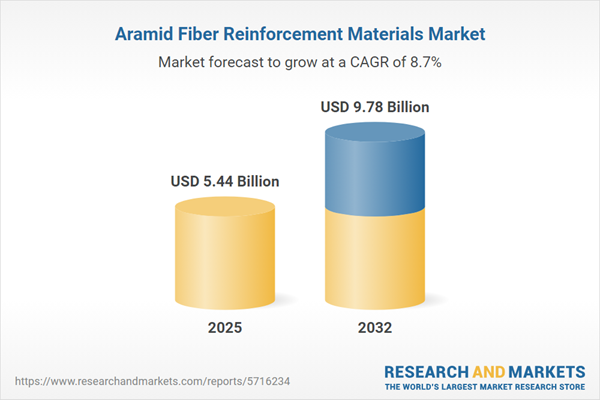Speak directly to the analyst to clarify any post sales queries you may have.
Senior executives seeking proven ways to boost organizational resilience and safety are evaluating the aramid fiber reinforcement materials market. This overview distills competitive priorities and core decision points, highlighting why aramid fibers support operational integrity in sectors facing increased technical and regulatory demands.
Market Snapshot: Aramid Fiber Reinforcement Materials Market
The global aramid fiber reinforcement materials market is on a robust growth trajectory, with significant revenue expansion and a strong compound annual growth rate (CAGR) forecasted. Sustained demand is fueled by the aerospace, defense, automotive, construction, and electronics industries, owing to the unique functional properties of aramid fibers. Leadership across these sectors values the consistent performance, strength, and durability these materials offer. As manufacturing advancements evolve, industry participants are investing in product lifecycle optimization and enhanced process reliability, positioning themselves to address competitive pressures and achieve higher safety standards. Key regional hubs continue to influence supply and demand dynamics, contributing to the sector’s forward momentum.
Scope & Segmentation: Aramid Fiber Reinforcement Materials Market
This analysis gives executive teams actionable segmentation and market scope, supporting strategic procurement and operational planning. The segments below guide resource allocation and market entry decisions based on current industry requirements.
- Fiber Types: Meta aramid fibers offer dependable thermal stability in challenging environments, while para aramid fibers excel where mechanical strength and long-term durability are critical.
- End-Use Industries: Aerospace prioritizes thermal management, automotive emphasizes lightweighting and occupant safety, construction focuses on robust structural solutions, defense leverages protective capability, electronics utilize insulation improvements, and chemical industries gain abrasion resistance for harsh handling conditions.
- Applications: Infrastructure cabling, advanced vehicle parts, personal protective equipment, technical ropes, and composite structures represent the key areas aramid fibers support in performance-focused designs.
- Products: Specialty fabrics, staple fibers, filament yarns, and aramid papers address the full spectrum of modern engineering and manufacturing challenges.
- Technologies: Dry and wet spinning methods maintain critical characteristics throughout manufacturing, ensuring reliability across diverse product specifications.
- Forms: Chopped and continuous fibers provide tailored solutions for both high-volume production and project-specific requirements.
- Channels: Aftermarket and OEM distribution networks enable prompt, responsive service for end users and integrators.
- Regions: Coverage spans Americas, Europe, Middle East, Africa, and Asia-Pacific, with industry concentrations in the United States, Canada, Germany, and China supporting reliable regional solutions.
- Key Companies: DuPont de Nemours, Inc., Teijin Limited, Kolon Industries, Inc., Hyosung Corporation, Toyobo Co., Ltd., Toray Industries, Inc., Yantai Tayho Advanced Materials Co., Ltd., SINOPEC Shanghai Petrochemical Company Limited, Hexcel Corporation, and Taekwang Industrial Co., Ltd. are prominent suppliers competing in this space.
Key Takeaways for Senior Leaders
- Deploying aramid fiber reinforcement materials can strengthen compliance with stricter safety and performance standards while reducing risks across assets and personnel.
- Integrating modern manufacturing approaches such as automated fiber placement and additive techniques boosts responsiveness to shifting technical needs.
- Collaboration with material suppliers and fabricators enables precise, application-specific solutions, increasing operational flexibility amid sector changes.
- Pursuing circular economy practices in manufacturing and recycling aligns procurement operations with evolving environmental mandates in global industries.
- Continuous engineering enhancements in fire and thermal performance ensure organizations are prepared for higher safety expectations in established and new domains.
- Targeted investment in geographically diverse markets, especially Asia-Pacific and the Middle East, enhances supply chain resilience in times of uncertainty.
Tariff Impact: US Tariffs and Supply Chain Adaptation
Current US tariffs on aramid fibers are prompting senior leaders in automotive and defense to reevaluate sourcing strategies. Regional supplier engagement and distribution diversification have become central to controlling costs and maintaining consistent material flow. This adaptive supply chain approach helps organizations actively manage volatility and minimize disruption across international operations.
Methodology & Data Sources
This report integrates executive interviews, input from industry specialists, targeted market research, and trade data analysis with scenario-based modeling. Drawing on multiple credible sources, it provides reliable and practical market intelligence tailored to the realities of the aramid fiber reinforcement materials sector.
Why This Report Matters for Strategic Decision-Makers
- Market segmentation and competitive benchmarking enable leaders to identify growth areas and strengthen position within the aramid fiber reinforcement materials market.
- Actionable recommendations guide the use of emerging technologies, encourage supply chain agility, and reinforce compliance with new industrial frameworks.
- Comprehensive market analysis equips executives with intelligence needed to proactively address shifting industry requirements and operational risks.
Conclusion
Executive teams can use this report to make clear, informed investments, support ongoing innovation, and navigate complexities in today’s aramid fiber reinforcement materials market landscape.
Additional Product Information:
- Purchase of this report includes 1 year online access with quarterly updates.
- This report can be updated on request. Please contact our Customer Experience team using the Ask a Question widget on our website.
Table of Contents
3. Executive Summary
4. Market Overview
7. Cumulative Impact of Artificial Intelligence 2025
Companies Mentioned
The companies profiled in this Aramid Fiber Reinforcement Materials market report include:- DuPont de Nemours, Inc.
- Teijin Limited
- Kolon Industries, Inc.
- Hyosung Corporation
- Toyobo Co., Ltd.
- Toray Industries, Inc.
- Yantai Tayho Advanced Materials Co., Ltd.
- SINOPEC Shanghai Petrochemical Company Limited
- Hexcel Corporation
- Taekwang Industrial Co., Ltd.
Table Information
| Report Attribute | Details |
|---|---|
| No. of Pages | 188 |
| Published | November 2025 |
| Forecast Period | 2025 - 2032 |
| Estimated Market Value ( USD | $ 5.44 Billion |
| Forecasted Market Value ( USD | $ 9.78 Billion |
| Compound Annual Growth Rate | 8.7% |
| Regions Covered | Global |
| No. of Companies Mentioned | 11 |









